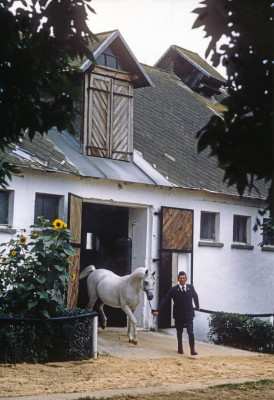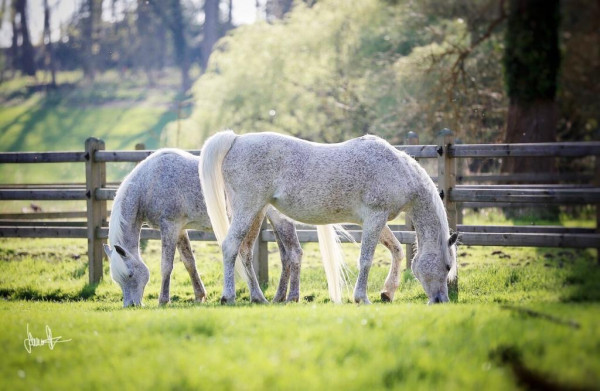In Consideration of the Arabian Horse, Part Two, with Rob Bick
I love starting horses because in the first three or four months of training you get to see the biggest changes in them. They go from being a blank canvas, to wearing tack, to going under saddle and getting into a frame and finding their balance. To me, that is fascinating. I don’t break as many as I used to – I’m a little older and not as limber as I used to be. I probably don’t have the confidence that I had when I was 20 and 30. I used to be like a cat up there. I’m not quite cat-like any more.
I enjoy it, though. And I love helping people start them.
The first month after saddling is when you can have a horse develop a great work ethic, or an “I hate being ridden,” attitude.
You can act like a rooster and scare a horse off, or you can walk out and be a little humble, relaxed, and keep your heart rate down and talk to them easy, and things will go pretty well. |
Here’s a tip: Many people who have been in the Quarter Horse world tend to make the same mistake with Arabs – they don’t take their spurs off when they get on these green horses. They are over-stimulated by spurs, and then the trainer blames the horse, who is squirming and swishing its tail. I have found that Arabians don’t need those spurs for the first three or four months. They are more sensitive than that.
Wait until they accept your leg being wrapped around them, being pushed around a little, before you start tuning them up. I find that when horses are having trouble with the beginning of their training, they’re overstimulated – everything is just too assertive. Wait until the horse is comfortable just being ridden.
 A two-year-old learning to bit off the halter.
A two-year-old learning to bit off the halter.
For most horses I use a smooth snaffle and a halter underneath, and I run the lead line through the rings on the snaffle and they learn to soften to that. It’s a good foundation for them to understand the next steps without being afraid. They learn one side separately from the other. They’ll learn about moving around your leg and moving to your hand. A lot of times the horse will not want to let go of the bit because they’re afraid of what’s coming. When they don’t feel anything and then suddenly it’s too sharp, they try to grab the bit and not let go of it. They don’t want to let go of it because it comes back with too sharp a pressure.
Often the horse will become heavier with more severe bits instead of softer. We need more leg not more bit.
It’s importantto preserve a young horse’s confidence. You don’t want the horse to feel as though you’re asking him to do something that he cannot do. Keep it simple. Teach him a conditioned response. And then teach him another one. And then add those two responses together. That horse now knows when he is cued to do this, when I feel his mouth on one side, he comes over without having to be kicked or pulled or over-corrected.
We need more leg not more bit.
If a horse is having trouble, break it down to the simplest one thing. Help him do one thing right. A horse that is confused and frustrated will not do one thing right. Allow those horses to learn one thing at a time, so that their attitude is “I can do this.” And they look forward to the next thing.
How do I convey to the horse that I’m happy with him and the effort he made? Horses don’t understand English, they understand posture and tone. It’s my tone of voice, and what I call “posturing.” Horses communicate through posturing. When you put a horse out in the field you will see a little flick of the tail or a little ear twitch, or just a look – he is telling another horse, “Hey! I’m talking to you.”
Absence of pressure is a reward for anything that is stimulating a horse – you take that away and that’s a reward. Horses seek comfort. If you reward him by dropping your pressure or your tone of voice, or give him a soft brush on the neck, that’s as good as a carrot. And by the way, some horses don’t like being patted.
You want to know about your horse? Clean his stall.
You can’t plan your training sessions exactly because it’s going to change. And you have to be willing to change your posture and what you are asking of the horse at any time, depending on how that horse is reacting. By the time you walk back to the barn, the plan that was in your head could be 100% different from what actually happened.
They can sense your attitude towards them so always approach training in a confident calm manner.
You can act like a rooster and scare a horse off, or you can walk out and be a little humble, relaxed, and keep your heart rate down and talk to them easy, and things will go pretty well.
A horse that’s a problem is generally challenging you in the pecking order, and if that’s happening you have to tell him, “Look, I am above you in the pecking order and once you accept that we are going to get along great!”
Once you have a horse that’s in your camp and he knows that you are the leader, then you are going to get those moments where that horse is anticipating what you want, and is happy to do that. Most horses are willing to work with you. Most horses want to please people.
They can sense your attitude towards them, so always approach training in a confident calm manner. |
I learn something new about horses every day. I’m not wasting as much time as I used to. I know better now to turn that around. Having seen a lot of things, I can find a routine that works. I’ve got different ways to work around their issues. And sometimes it’s just that – working around their issues. I’ve learned a lot from some of the problem horses and helping them turn things around in their lives a little bit.
Here’s a thought: people always think about a horse being light or soft as a sensitivity in their mouth. I think of it more as being related to balance or the horse’s ability to put his hind leg under his body.
It’s important to preserve a young horse’s confidence.
If a horse is going to get light and soft, he has to put all four legs under your body, and be balanced underneath you. This enables the horse to move easily and gracefully from one gait to another. The balance comes from their hind leg. A lot of training is really how much control do you have over your horse’s hind leg, with your leg and feet? Softness comes off of that kind of training. There’s a lot of difference between “light” and “soft.” Ideally you want a horse that is “soft” and “light.” You don’t want a horse that is heavy. But I’d rather have heavy and soft, than light and stiff.
Heavy and soft might plow you around but it won’t hurt you. Light and stiff can flip over backwards on you.
When a horse gives to a pressure you have to be willing to give it back. The difference between a hold and a pull is the release. Your release time is really important. If the horse responded by coming away from pressure, you give it back to him instantly so that he feels that release. Absence of pressure is the reward.
I stepped away from training for a couple of years, and focused on the breeding. I enjoy going to the barn and playing with the horses. I’m following what is interesting to me. Actually, I love this conversation because I feel like I’m giving back…sharing my tips, my experience.
 “Most horses are willing to work with you, and want to please people.”
“Most horses are willing to work with you, and want to please people.”
Today I am enjoying working with the young ones. Even the foals, just meeting them in the pastures, and simply being around them. I clean stalls in the morning for exercise. I also get to interact with the crew at that time. And another tip: You want to know about your horse? Clean his stall. You’ll see how lives, what he’s eating. We also have one mare that comes and puts her head on your shoulder when you go in to clean her stall.
In a lot of ways, that’s everything.

























